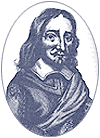John Okey facts for kids
Quick facts for kids
John Okey
|
|
|---|---|

Colonel John Okey
|
|
| Member of Parliament for Bedfordshire |
|
| In office January 1659 – May 1659 |
|
| Personal details | |
| Born | 24 August 1606 (baptised) City of London |
| Died | 19 April 1662 (aged 55) Tower Hill, Middlesex |
| Resting place | Tower of London |
| Nationality | English |
| Spouses | (1) Susanna Pearson (1630-1656) (2) Mary Blackwell (1658-his death) |
| Alma mater | Exeter College, Oxford |
| Occupation | Political and religious radical, regicide and Parliamentarian soldier |
| Military service | |
| Years of service | 1642 to 1646 |
| Rank | Colonel |
| Battles/wars | First English Civil War Braddock Down; Beacon Hill; Modbury 1643; Sourton Down; Stratton; Lansdown; Roundway Down; Bristol |
Colonel John Okey (born August 24, 1606 – died April 19, 1662) was an important figure during the English Civil War. He was a soldier in the Parliamentarian army. Okey was one of the people who approved the execution of King Charles I in 1649. After the king's son, Charles II, came back to power, Okey had to flee England. He was later caught and executed in 1662.
Contents
Early Life and Military Career
John Okey was born in London on August 24, 1606. He came from a well-known family. Before the English Civil War began, Okey worked at a brewery. He later became the owner of a business that supplied ships.
When the war started, Okey joined the Parliamentarian army. He quickly showed his skills and rose through the ranks. He became a captain and then a major. In 1645, he was made a colonel in charge of a special unit called Dragoons. These were soldiers who rode horses but fought on foot.
Key Battles and Achievements
Okey's dragoons became famous for their actions at the Battle of Naseby. They started the battle by firing at the Royalist army from a hidden spot. Later, they made one of the first mounted charges by English dragoons. His regiment also helped save another cavalry unit from defeat. Okey fought in other important battles, including Boroughbridge and Bath. He was captured once during the siege of Bristol but was released when the city surrendered.
After the first civil war, Okey's regiment also fought in the second civil war in South Wales in 1648. They were involved in the battle of St Fagans and the siege of Pembroke Castle.
Role in King Charles I's Trial
In 1648, King Charles I was put on trial. He was accused of starting a war against Parliament and the people. John Okey was chosen as one of the judges for this important trial. He was one of 135 men selected by Parliament.
Okey was actively involved in the trial. He was present for most of the court meetings. He was also one of 59 people who signed the document that ordered the king's execution. This made him a key figure in a major historical event.
Religious Beliefs and Influence
John Okey held strong religious beliefs. He was a Baptist and a Congregationalist. These beliefs guided his actions, even in his military career. After the Battle of Naseby, he wrote about how God helped the Parliamentarians win.
In 1652, Okey asked Parliament to make some religious changes. He wanted to spread the Christian message and improve the church system. There is also evidence that he helped create John Bunyan's Baptist church in Bedford in 1653. Okey believed his actions were "for righteousness and for justice" and for promoting a good government and church.
Challenging Oliver Cromwell
In 1654, Okey joined two other colonels, Thomas Saunders and Matthew Alured, to sign a document. This document, called the "Petition of the Three Colonels," criticized Oliver Cromwell. Cromwell was the leader of England at the time, known as the Lord Protector.
The petition was not successful. Although only one of the colonels was imprisoned, all three, including Okey, were removed from the New Model Army. After this, Okey retired to Bedfordshire, where he had bought a lot of land. He was later elected as a Member of Parliament for Bedfordshire in 1659.
Arrest and Execution
When the monarchy was restored in England in 1660, a law called the "Act of Pardon" was passed. This law forgave most people for their actions during the civil war. However, some people were not pardoned, especially those involved in the execution of King Charles I.
John Okey knew he would not be pardoned, so he fled to Germany with another man named John Barkstead. By fleeing, he lost his right to a trial and was declared an outlaw.
In 1662, while in the Netherlands, Okey was arrested. He was caught along with Barkstead and Miles Corbet by the English ambassador, Sir George Downing. The three men were immediately sent back to England. Since they had already been declared outlaws, their trial only focused on proving their identities.
John Okey and his companions were executed on April 19, 1662, at Tower Hill in London. Okey's family wanted to bury him in Stepney next to his first wife. However, a large crowd gathered to honor him, so he was buried inside the Tower of London.

